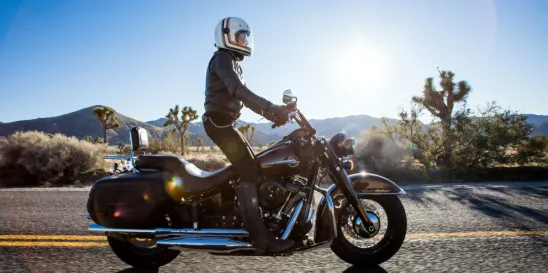One of the most vivid feelings we have from our childhood
is when we learned to bike.
On a bicycle,
we were in control,
going faster than we ever did before,
the exhilarating wind is flowing on our faces.
And invariably, we ended up with
“Look Ma, No Hands!”
What a feeling!
Why can’t we have the same feelings again, even as grown-ups?
Yes, we can but this time not on the two-dimensional ground
but in a three-dimensional space.
Sounds scary!
So what, life is all about experiences and reliving our memories. Hoverbikes offer us the chance to relive
that long-lost part of our childhood.
Overview
A hoverbike is a motorbike-like flying vehicle that hovers above the ground and travels in the air, not on the ground.

Image Source: XTURISMO by AERWINS
Built using lightweight materials and electric power, hoverbikes aim to provide efficient and eco-friendly mobility solutions for cities. Computer-controlled stabilization systems and laser scanners for obstacle detection ensure safety and precision in hoverbikes.
The global hoverbike market is on a remarkable growth trajectory, expected to surge from USD 66 billion in 2022 to a staggering USD 329 billion by 2032, with a CAGR of about 19% during the period from 2023 to 2032, according to Precedence Research.

Source:: Precedence Research
The North American region is anticipated to experience slower but substantial growth, with a CAGR of 8.7% from 2023 to 2032.
Notably, the Asia-Pacific region is leading the way, accounting for more than 36% of the revenue share, whereas North America accounted for 29% in 2022.
India Story
Although India has progressed tremendously in the last two decades in the indigenous design and development of vehicles, futuristic vehicles are still rarity on Indian roads, much less in Indian skies.
However, AERWINS Tech’s XTOURISMO has intrigued Anand Mahindra, Chairman of Mahindra Group of Companies. The Group’s company Mahindra & Mahindra is the fourth largest automobile company in India and among the top 25 automobile companies in the world. It has a tradition of embracing emerging technologies. Perhaps, we will see a Mahindra hoverbike in the not-so-distance future.
Meanwhile, young Indian engineers are currently leading the efforts, using the “jugaad” method, a non-conventional, frugal innovation, often termed a "hack".
Engineering students at Netaji Subhash Technology University in Delhi have used Triumph Daytona 675cc engine to develop a prototype hoverbike.

Image Source: The Times of India
It is a lightweight yet powerful three-cylinder engine weighed about 47 kilogram or about 100 pounds. It is capable of producing maximum 70.2 newton-meter of torque at 9,900 rpm and maximum 118 horsepower at 12,300 rpm.
This functional prototype still needs work, but it achieved a significant milestone on April 12, 2022, when it successfully executed its first valid lift-off.
Underlying Technologies
Propeller
A blade propeller consists of a rotating hub with radiating blades set at a pitch, creating a helical spiral that generates linear thrust. It reduces drag and enhances efficiency.
Multiple propellers are strategically placed to overlap, reducing the vehicle's footprint. A ducted fan design is employed to enhance efficiency and minimize noise.
Motor
A brushless motor efficiently converts electrical energy into mechanical energy using an electronic controller that switches DC currents to motor windings. It achieves precise control and high rotational speeds.
Battery
With electrification all around in mobility, hoverbikes are most likely to use battery-based electric propulsion systems, though some can be hybrid with internal combustion engines to improve the range.
Large-capacity batteries, typically lithium-based like LiPo, are used to extend flight time due to their high energy density. They power both propulsion and onboard systems.
Electronic Speed Controller (ESC)
ESCs manage motor speed based on user input and include a Battery Eliminator Circuit (BEC) to reduce voltage for other devices. They provide precise control of hoverbike propulsion systems.
Transmitter and Receiver
Transmitters and receivers enable wireless control on the 2.4GHz radio frequency, reducing interference and extending the range for remote operation. They are essential for piloting hoverbikes from a distance.
Flight Controller
The flight controller integrates with sensors like accelerometers and gyroscopes to stabilize the hoverbike. It processes user input and sensor data to ensure stable flight and safe operation.
On the Market, Now or Soon…
XTOURISMO by AERWINS Tech

Image Source:: XTURISMO by AERWINS
AERWINS Technologies Inc. of Japan shipped first XTOURISMO hoverbike in December 2022. It flies about 3 meters above the ground and flies at 80 to 100 kmph. It uses six propellers to provide the lift and propulsion. The company has also developed a platform (COSMOS) for planning, monitoring and management of air mobility.
R1200GSA Hover Ride by BMW and LEGO
BMW Motorrad and LEGO Technic introduced this hoverbike concept, a replica of its popular motorbike, in 2017 with an aim to have the fully functional version by 2024. It uses anti-gravity thrusters for the lift and dampers to stabilize the vehicle in air.

Image Source: BMW Motorrad
La Moto Volante 496 by LaZareth Auto-Moto

Image Source: Lazareth Auto-Moto
LaZareth introduced the hoverbike version of its powerful LM847 motorbike with four wheels in January 2019. It combines electric propulsion with turbo-propulsion for the lift. It has 60 miles of on-road range and 10 minutes of flight.
Kalashnikov Concern JSC
Russian defense company, Kalashnikov Concerns, the maker of famous AK-47, conducted a demo flight of its working prototype of a hoverbike in 2017. Except for the video released by the company, no details are available on the further development.

Image Source: Kalashnikov Concerns JSC
Who Would Be Interested?
Disaster Relief
- Provide emergency food supplies to trapped flood victims.
- Rapidly evacuate people from disaster areas.
- Rescue people stranded in mountains.
- Support wildfire fighting operations.
Police and Enforcement Agencies
- Surveillance of and help in capturing absconding suspects.
- Emergency airlift for accident victims.
- Maintenance of law and order in large mass gatherings.
- Wildlife monitoring at national park services.
Military
- Border surveillance.
- Clean up areas with landmine and unexploded ordnance.
- Rapid transport for weapons, food, drinking water, fuel and medicine to frontlines.
- Selectively and rapidly target enemy assets.
Energy and Utilities
- Visit remote pumpjacks in oil fields.
- Inspect oil pipelines passing through rough terrains.
- Check hydropower dams from outside.
- Inspect and power wash solar power plants.
Transportation
- Personal transport vehicle for individuals.
- Urban commute options.
- Food and package delivery services.
Agriculture & Ranching
- Manage herds of livestock in large, spread-out ranches.
- Spray fertilizer and pesticides on crops.
Recreation
- Sport racing and X Games.
- Recreational flying.
- Tourism.
Legal and Operational Considerations
Flying Regulations and Air Traffic Control
While there is no specific mention of hoverbikes in regulations in India, the Ministry of Civil Aviation and the Directorate General of Civil Aviation (DGCA) are likely to regulate the operation of airborne vehicles like hoverbikes.
The regulations would cover issues such as airworthiness, personnel requirements, vehicle registration, permitted flight altitude, security, airspace management, and prohibited uses. For instance, drones are permitted to fly up to a vertical distance of 400 feet for all unrestricted ‘green’ zones, but are prohibited to fly in zones that are close to airports, international borders, defense areas, key government sites, etc.
At some point, a similar regulatory framework may be considered for hoverbikes. Depending on the category of hoverbikes, certain technologies may also be required based a risk-level analysis, such as surveillance cameras, anti-collision technologies, speed restrictions, etc.
Safety
Perhaps, the biggest concern with hoverbikes is safety. Regulators need to develop safety regulations and an enforcement mechanism to ensure hoverbikes meet safety standards. At minimum, hoverbikes need to have their own enveloping airbags and rescue parachutes that may automatically activate when any malfunction happens.
Torts and Liabilities
There may be numerous chances of misuse of hoverbike capabilities, attracting existing tort laws, criminal laws and consumer rights laws. It may also be argued that harm is caused by damage to land or interference of peaceful enjoyment of property. The regulations should address liability assignment in the case of accidents or falling of a failed hoverbike on people or property.
Privacy and Surveillance
Hoverbikes can fly very close to buildings. Flying a hoverbike over private property may be deemed as trespass. There will be a need to address concerns about privacy, especially with surveillance-equipped hoverbikes. Other claims such as breaches of privacy, harassment, hurt and negligence may also arise.
Data Protection
Hoverbikes have technological equipment, sensors and software that collect varied amounts of personal data including location data. In India the Digital Personal Data Protection Act (DPDPA) would govern the treatment of data. Similarly, considerations under geospatial laws would also have to be factored in relation to processing of data.
Cybersecurity
Since hoverbikes would rely extensively on advanced technology for navigation, communications, and governance, they may be vulnerable to cybersecurity incidents or breaches, especially hacking. The Indian cyber security laws prescribe that certain category of cybersecurity incidents must be mandatorily reported within a prescribed timeline. Therefore, incidents such as malware attacks and hacking into systems controlling hoverbikes may also trigger such reporting requirements.
Environmental Impact
Electric powered hoverbikes have zero emission, so they are environment friendly and produce relatively low noise. However, some hoverbikes have hybrid engines, with internal combustion engines and electric battery powered motors, so noise pollution and energy consumption are important considerations.
Zoning and Land Use
To ensure safety of people, properties and hoverbikes, local governments need to designate areas for hoverbike landings. To avoid undue intrusions and safeguard security, they should also establish fly and no fly zones..
Pilot Training and Licensing
Just as in the case of motorbikes and automobiles, special licensing agencies need to be established to assess the skills and abilities of the hoverbike drivers. Registration agencies should also issue licenses to operate. Special courses and training programs may also need to be developed for hoverbike drivers.
Click here to listen to the five-part Podcast of this issue from your favorite podcast directory.
Click here to view the five-part Videos of this issue from your favorite video channel.
Sources and Further Reading
- Flying Bikes (Hoverbikes) Market. Precedence Research. January 2023.
- Hoverbike. Skyfi Labs. 19 May 2022.
- Flying Bikes (Hoverbikes) Market Size by Application. The Brainy Insights, February 2023.
- XTURISMO Hoverbike steers a sci-fi dream, realises the future of air mobility. StirWorld. 31 Oct 2022.
- World’s first rideable hoverbike looks cool as hell but will probably kill you. The Verge. 20 Feb 2017.
- India’s first flying motorcycle made by Delhi-based engineers! Trackbike to hovercraft. The Times of India. 13 April 2022.
- Futuristic hoverbikes set to join Dubai’s police fleet. SpringWise. 1 Nov 2017.
- Icon/Cliparts: https://www.pngkit.com/ .
Some Hoverbike Companies
- AERWINS Technologies - https://aerwins.us/
- Malloy Aeronautics - https://www.hover-bike.com/hoverbike/
- Aerofex - https://aerofex.com/
- LaZareth - https://www.lazareth.fr/
- Volocopter - https://www.volocopter.com/
- Ehang - https://www.ehang.com/
- Hoversurf - https://www.hoversurf.com/





 />i
/>i

